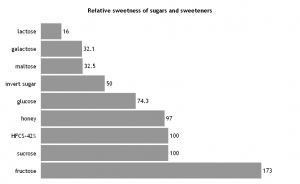Relative sweetness
The primary reason that fructose is used commercially in foods and beverages, besides its low cost, is its high relative sweetness. It is the sweetest of all naturally occurring carbohydrates. Fructose is generally regarded as being 1.73 times as sweet as sucrose. However, it is the 5-ring form of fructose that is sweeter; the 6-ring form tastes about the same as usual table sugar. Warming fructose leads to formation of the 6-ring form.
The sweetness of fructose is perceived earlier than that of sucrose or dextrose, and the taste sensation reaches a peak (higher than that of sucrose) and diminishes more quickly than that of sucrose. Fructose can also enhance other flavors in the system.
The principal of addiction
swift peaks and troughs are the principals of any addiction
Eating Fruit in the Community is usually a natural way to self limit the amount of Fructose we consume
Fruits – dried or fresh – are a rich source of soluble fibre; this is material that is not absorbed by the intestines and instead remains within the bowel contents where it binds water; this increases the faecal water content and hence bulk. This promotes intestinal motility and the softer consistency makes the resulting stools easier to pass.
Dried fruits tend to be even more effective at provoking this result because – by virtue of being dried – they are less filling than their fully hydrated fresh counterparts and hence we tend to eat more of them in a portion; this means that the dose of soluble fibre, which is unaffected by the drying process, is higher and hence the aperient effect is more, shall we say, apparent!
Dietary guidelines for the management of fructose avoidance / minimization
Researchers at Monash University in Australia developed dietary guidelines for managing fructose malabsorption.
Unfavorable foods (i.e. more fructose than glucose)
- Fruit — apple, pear, guava, honeydew melon, nashi fruit, pawpaw, papaya, quince, star fruit, watermelon;
- Dried fruit — apple, currant, date, fig, pear, raisin, sultana;
- Fortified wines
- Foods containing added sugars, such as agave nectar, some corn syrups, and fruit juice concentrates.
Favorable foods (i.e. fructose equal to or less than glucose)
The following list of favorable foods was cited in the paper: The fructose and glucose contents of foods listed on the Australian food standards website would appear to indicate that most of the listed foods have higher fructose levels.
- Stone fruit: apricot, nectarine, peach, plum (caution — these fruits contain sorbitol);
- Berry fruit: blueberry, blackberry, boysenberry, cranberry, raspberry, strawberry, loganberry;
- Citrus fruit: kumquat, grapefruit, lemon, lime, mandarin, orange, tangelo;
- Other fruits: ripe banana, jackfruit, kiwi fruit, passion fruit, pineapple, rhubarb, tamarillo.
